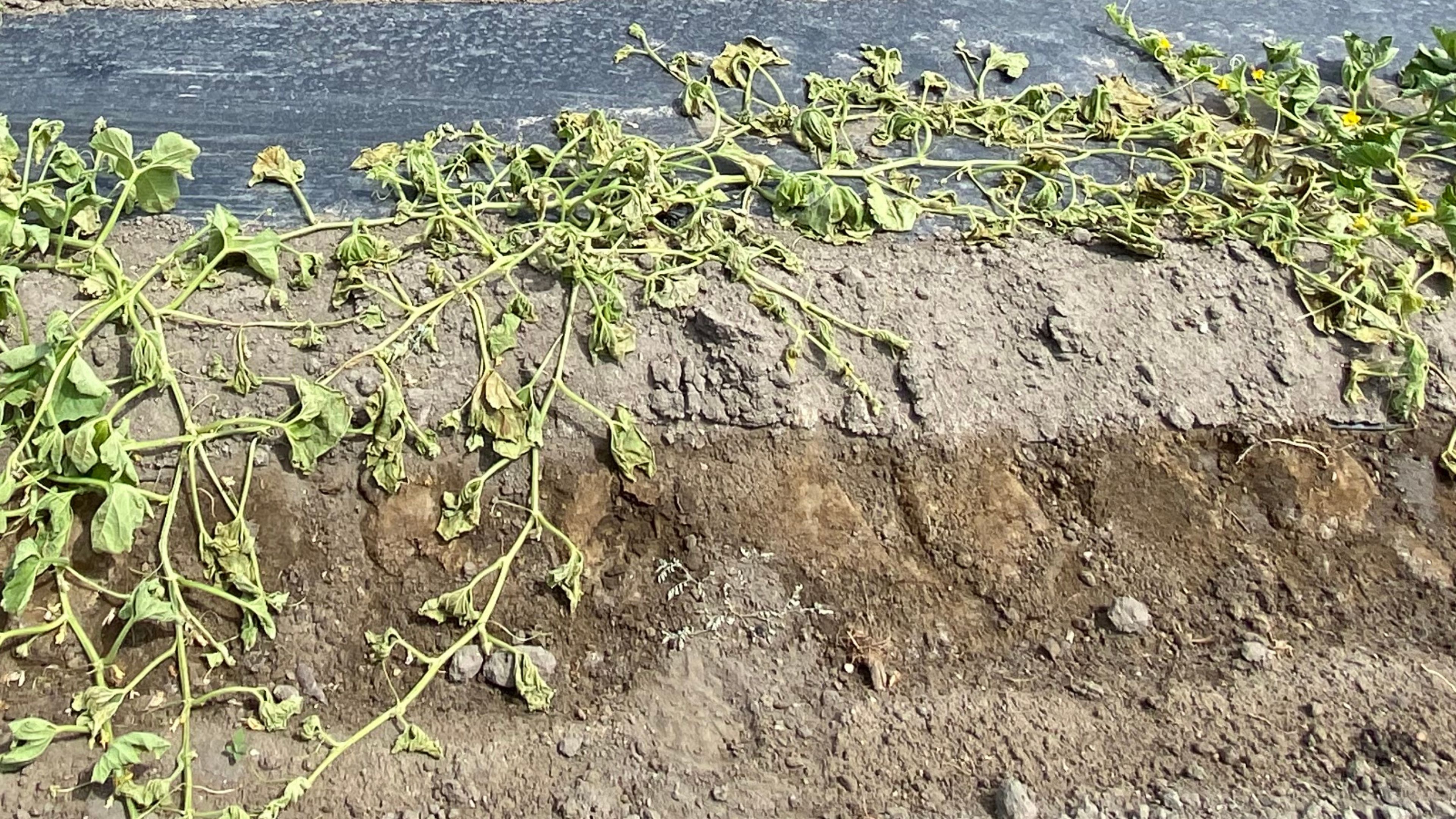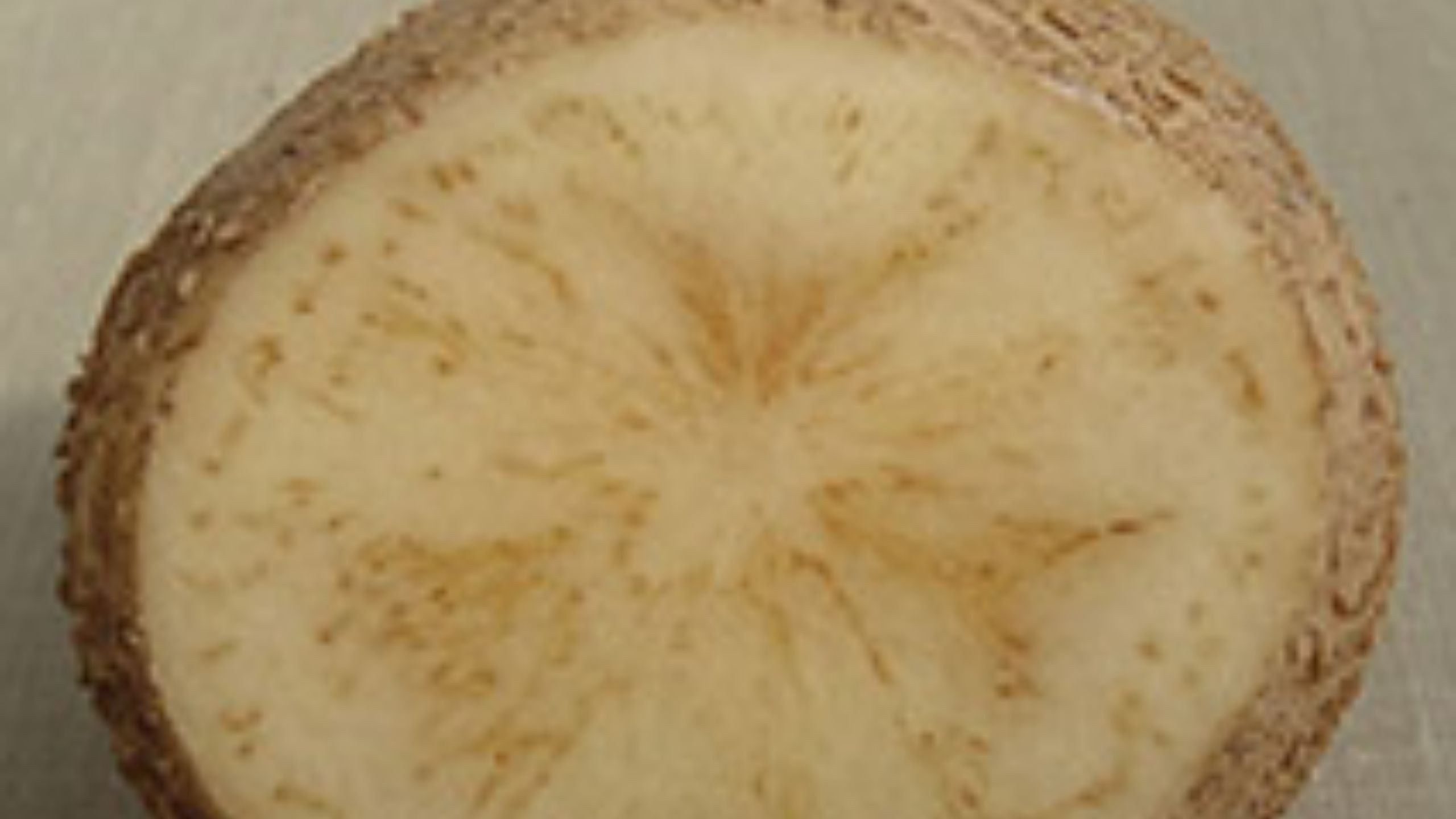Onion Powdery Mildew
(Leveillula taurica)
April 2008
Kent Evans, Extension Plant Pathology Specialist • Dan Drost, Extension Vegetable Specialist • Erin Frank, USU Plant Disease Diagnostician

Fig. 1. Onion powdery mildew appears as white fungal mycellium on the leaves of onions. These symptoms occurred in early September on onions grown in Box Elder County, Utah, Summer 2007.

Fig. 2. A closeup view of the Leveillula taurica pathogen growing on an infected onion leaf found in Box Elder County, Utah, in 2007.

Fig. 3. Primary spores, called conidia, are pointed or lanceolate (see arrow).

Fig. 4. Secondary conidia are cylindrical and rounded (see arrow).

Fig. 5. Visible mycelium of L. taurica appears as white coarse-textured fungal growth. It is less fine-textured compared to many other powdery mildew diseases.
Quick Facts
- Onion powdery mildew (OPM) is caused by Leveillula taurica (Lév.) G. Arnaud, a fungal pathogen that has the ability to parasitize a very broad range of plant species.
- The pathogen can only grow on living host tissues and is thought to carry over from one season to the next on infected plant residue.
- The disease has occured on onions in California, Washington, Idaho, and Utah, respectively. In Utah, this disease was first identified on onions in Box Elder County in September 2007.
- At present there are a number of fungicides available to treat this disease, although none have been needed in Utah to date.
- Resistance among cultivars is reported in onions; however, due to the infrequent occurrence of onion powdery mildew, cultivar screening has not occured in Utah.
- Cleaning tillage and crop rotation are the best control options.
- Onion powdery mildew is a new disease occuring in Utah and should be monitored to be sure it does not become a significant economic pest.
Leveillula taurica is a powdery mildew fungus capable of infecting onions, garlic, and over 1000 plants in various genera and species (Braun, 1987 and 1995). The disease was first reported in the western U.S. in California on onions in 1985 (Laemmlen and Endo, 1985). The disease was then observed in 2003 in the state of Washington (du Toit et al., 2004) on onions being grown in a field trial. In that report it was indicated the disease had occured there, infrequently, on onions in variety trials since 1996. The disease was first reported to occur in Idaho in 1994 as published in 2005 (Mohan, 2005). The first reported occurrence of OPM in Utah was on onions in a field trial located in Box Elder County, Utah, in 2007. The disease also occurs on onions and garlic in Israel and southeastern Europe. L. taurica can parasitize a number of crop species including cucumber, peppers, eggplant, and tomato.
Symptoms
Early infection symptoms of OPM appear as whitish lesions (Fig. 1) on older leaves and later, when conditions are conductive, the fungus will produce visible mycelium with prolific numbers of spores (Fig. 2). The asexual spores are dimorphic (two types). Primary spores, called conidia, are pointed or lanceolate (Fig. 3) and secondary spores are more cylindrical and rounded on the proximal ends (Fig. 4). Areas with visible mycelium will begin to show chlorosis and eventually will become necrotic. This fungal pathogen can survive from one season to another in crop residues to infect susceptible crops the following season.
Disease Cycle
L. taurica is thought to overwinter from one season to the next in crop residue above the soil surface. The fungus produces chasmothecia, fungal reproductive structures of the sexual stage of the fungus, and when climatic conditions are favorable (specific moisture duration and favorable temperatures are not reported), the chasmothecia open to release ascospores. The ascospores are primarily spread by wind. The fungus enters the host through stomata to colonize tissues within the plant leaves. Eventually, the fungus will produce conidia, borne singly, or on branched conidiosphores that exit the stomates. The asexual conidia (Figs. 3 and 4) serve as secondary inoculum to spread the disease following the initial infection. Specific climatic conditions characterizing the specific epidemiological requirements for the different life stages of this pathogen are not well documented.
Diagnosis
OPM, in the earlier stages of development, may be difficult to differentiate from Iris yellow spot virus (IYSV), as it will produce lesions that are white and shaped similarly to the viral disease lesions. As OPM becomes more developed it is one of the easier diseases to diagnose onions. Visible mycelium will appear as coarse-textured fungal growth. A strong hand-lens (16-20X) will allow the observer to see the lanceolate at cylindrical dimorphic conidia (Figs. 1 and 2). OPM infections usually appear first on older leaves, and when the disease is more advanced, the lesions will chlorotic and/or necrotic. In more advanced disease development, and experienced observer can diagnose this disease on sight (Fig. 5) with little magnification, due to the coarse-textured appearance of the fungal growth and the pattern of the disease growing on the infected plants (Fig. 1). L. taurica is an endoparasitic fungus (grows within the plant host) that colonizes the leaf mesophyll. Ascospores (not shown), 20-35 two-spored asciper chasmothecium, are cylindrical to pyriform, slightly curved and variable in shape (12-22 X 25-40 μm). Conidia (Figs. 3 and 4) are lanceolate to cylindrical (25-95 X 14-20 μm) (Schwartz and Mohan, 1995).
Management
OPM is a disease that tends to appear towards the end of the growing season. If the disease appears in homeowner's garden onions, and application Kali-green (potassium bicarbonate) or baking powder (see Table 1) will help to control the spread of OPM, but will not eliminate it from infected leaves of affected plants. In commercial plantings, removal of the crop residue, using deep tillage, and rotating to a non-host crop following onions will help to eliminate the pathogen. Control of volunteer onions will preven the pathogen from carrying--over from one crop to the next. In the even that a grower feels it is necessary to use a fungicide, the strobilurin compound Cabrio is labeled for the control of Leveillula on onions. As with any chemical, labels often change; read the pesticide label and understand the specific application requirements before use. It is likely that only one or two applications may be required in any season.
Table 1.
| Chemical | Active Ingredient(s) | Rate |
|---|---|---|
| Cabrio | Pyraclostrobin | 8-12 oz/A |
| Kaligreen | potassium bicarbonate | 2.5-3 lb/A |
| Baking Soda | sodium bicarbonate | 2.5-3 lb/A |
Prevention
Planting seed or using high quality seedlings on transplanted into clean fields that were rotated out of onion production for at least one-year will minimize the chances of OPM from occurring. Scouting fields often will help to determine when and where the disease may occur and whether any control practices are required.
Resistant Varieties
Resistance is mentioned in literature (Mohan, 2005) regarding OPM; however, no cultivars are recommended over others for resistance to this disease.
References and Further Reading
- Braun, U 1987. A monograph of the Erysiphales (powdery mildews). Beih. Nova Hedwigia 89.1-700
- Braun. U. 1995. The Powdery Mildews (Erysiphales) of Europe. Gustav Fischer Verlag. Jena.
- du Toit, L. J., Glawe, D. A., and Pelter, G. Q. 2004. First report of powdery mildew of onion (allium cepa) caused by Leveillula taurica in the Pacific Northwest. Onion. Plant Health Progress DOI: 1094/PHP-2004-1129-01-HN.
- Laemmlen, F. F., and Endo, R. M. 1985. Powdery mildew (Oidiopsis taurica) on onion in California. Plant Dis. 69:451
- Mohan, S. K. 2005. Powdery mildew caused by Leveillula taurica on glossy leaf genotypes of onion in Idaho. Plant Dis. 89:431. Published online as DOI: 10.1094/PD-89-0431C.
- Schwartz, H.F., and Mohan, S.K. 2008. Compendium of Onion and Garlic Diseases and Pests, 2nd Ed. American Phytopathological Society, St. Paul, MN.
Related Research




















